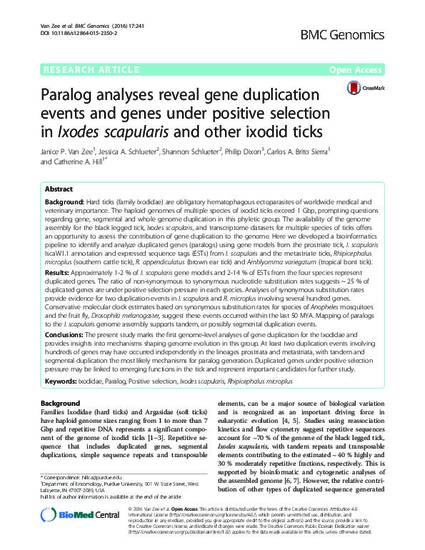
Background: Hard ticks (family Ixodidae) are obligatory hematophagous ectoparasites of worldwide medical and veterinary importance. The haploid genomes of multiple species of ixodid ticks exceed 1 Gbp, prompting questions regarding gene, segmental and whole genome duplication in this phyletic group. The availability of the genome assembly for the black legged tick, Ixodes scapularis, and transcriptome datasets for multiple species of ticks offers an opportunity to assess the contribution of gene duplication to the genome. Here we developed a bioinformatics pipeline to identify and analyze duplicated genes (paralogs) using gene models from the prostriate tick, I. scapularis IscaW1.1 annotation and expressed sequence tags (ESTs) from I. scapularis and the metastriate ticks, Rhipicephalus microplus (southern cattle tick), R. appendiculatus (brown ear tick) and Amblyomma variegatum (tropical bont tick).
Results: Approximately 1-2 % of I. scapularis gene models and 2-14 % of ESTs from the four species represent duplicated genes. The ratio of non-synonymous to synonymous nucleotide substitution rates suggests ~ 25 % of duplicated genes are under positive selection pressure in each species. Analyses of synonymous substitution rates provide evidence for two duplication events in I. scapularis and R. microplus involving several hundred genes. Conservative molecular clock estimates based on synonymous substitution rates for species of Anopheles mosquitoes and the fruit fly, Drosophila melanogaster, suggest these events occurred within the last 50 MYA. Mapping of paralogs to the I. scapularis genome assembly supports tandem, or possibly segmental duplication events.
Conclusions: The present study marks the first genome-level analyses of gene duplication for the Ixodidae and provides insights into mechanisms shaping genome evolution in this group. At least two duplication events involving hundreds of genes may have occurred independently in the lineages prostriata and metastriata, with tandem and segmental duplication the most likely mechanisms for paralog generation. Duplicated genes under positive selection pressure may be linked to emerging functions in the tick and represent important candidates for further study.
Available at: http://works.bepress.com/philip-dixon/59/

This article is published as Van Zee, Janice P., Jessica A. Schlueter, Shannon Schlueter, Philip Dixon, Carlos A. Brito Sierra, and Catherine A. Hill. "Paralog analyses reveal gene duplication events and genes under positive selection in Ixodes scapularis and other ixodid ticks." BMC genomics 17 (2016): 241. doi: 10.1186/s12864-015-2350-2.